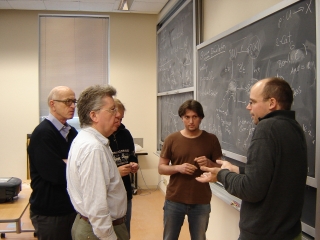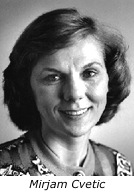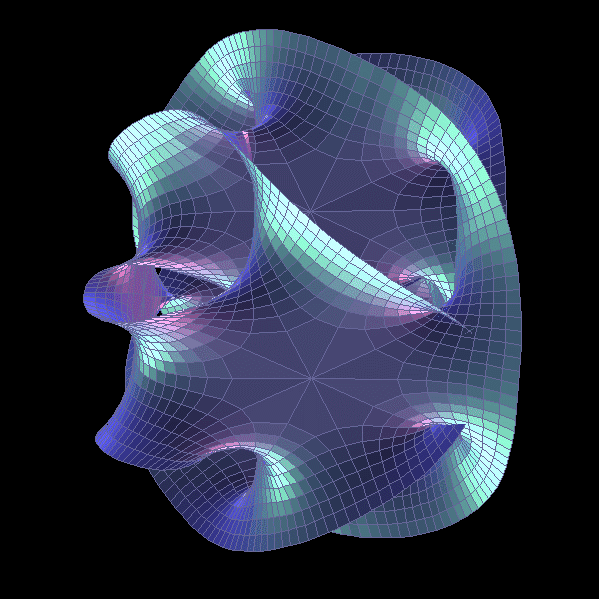
In my last post I entertained the idea of a possible M-theoretical computronium. By definition, computronium is a programmable substrate which can model virtually any object. So M-theory computronium is a realization of such a hypothetical substrate, using objects from M-theory. Along these lines, using the qudit/qubit correspondence, M-theory computronium would essentially be a substrate of programmable extremal black holes. So is an M-theory universe ultimately just a large-scale black hole quantum computer?
Leading researchers such as Seth Lloyd and David Deutsch have argued that the universe, as a giant quantum mechanical system, is indistinguishable from a big quantum computer. Lloyd has stated [1] that since all elementary particles and their interactions register and process quantum information, the universe is constantly performing quantum computations. Moreover, since elementary particles such as the electron and photon can be mapped to qubits and qutrits, their interactions can be seen as the result of quantum logic operations, i.e., quantum computational gates. Hence, the collection of all such qudit computations is indistinguishable from the universe itself.
The arguments by Lloyd and Deutsch are convincing, but from the perspective of string/M-theory we can go one step further, and note that all elementary particles actually arise from more fundamental higher-dimensional objects. In string theory, the popular explanation was that all elementary bosons and fermions arise from vibrations of a string. However, in 1995, after Edward Witten showed that the five known, consistent superstring theories are related by dualities, and it became clear that there was a deeper theory in 11-dimensions, called M-theory that was behind it all. Such a theory, at low energies becomes the unique D=11 supergravity, and contains (among other things) two-dimensional and five-dimensional branes (M2-branes and M5-branes), but no strings. So, from an M-theory perspective all elementary particles should arise from objects in eleven-dimensions, such as the M2 and M5-branes and their various configurations.
In attempting to recover elementary particles from M-theory one might attempt to study BPS-saturated solutions in supergravity theories, which are believed to survive at the full quantum level and give a glimpse of the true, non-perturbative structure of M-theory. The easiest way to find such BPS solutions is searching for extremal p-brane solitons, either in D=10,11 or in Kaluza-Klein reductions to lower dimensions. The Kaluza-Klein reductions, which include toroidal compactifications of M-theory, are especially quite nice as the procedure preserves all the original supersymmetry of the full D=11 configuration. This means, given a lower dimensional extremal BPS solution, it can be "oxidized" back up into a higher dimensional supergravity solution that preserves the same amount of supersymmetry.
The simplest extremal BPS solutions are those that preserve 1/2 of the original supersymmetry. These are solutions that contain a single charge, carried by a single field strength in supergravity. Such solutions arise in toroidally compactified M-theory down to dimensions D=3,4,5,6, and take the form of 1/2 BPS black holes.
In D=4,5,6 compactifications (M-theory on T^7, T^6 and T^5), Duff et al. noticed [2] that extremal black holes and entangled qubits share the same invariants and algebraic structures. On the M-theory side the invariants give the entropy of the black holes, while also helping to classify the various BPS solutions. On the quantum information side, the invariants help to classify the entanglement classes for qubits and qutrits. In D=3 compactifications, this black hole/qudit correspondence was even used by Levay [3] and Duff [4] to predict 9 entanglement families for four entangled qubits, where in quantum information theory the exact number has yet to be determined and predictions range from 8 to 21 families.
Recently, it has been shown [5] that by defining generalized qubits and qutrits over composition algebras (e.g., the quaternions, octonions and their split forms, etc.), it is possible to directly identify 1/2 BPS black hole solutions in D=5,6 with these generalized qubits and qutrits. This allows one to interpret qubits and qutrits (qudits) with the simplest extremal black hole solutions that contain a single charge and preserve 1/2 supersymmetry. The U-duality groups of the corresponding D=5,6 supergravity theories are then interpreted as transformations of these qudits through stochastic local operations and classical communication (SLOCC). This gives rise to new kinds of SLOCC gates in quantum information theory, which in the case of a non-associative composition algebras, endows qubits with SO(9,1), SO(5,5) symmetry and qutrits with the symmetry of the E6 exceptional Lie group.
It is quite remarkable that E6 can be interpreted as the SLOCC symmetry group of qutrits over non-associative composition algebras. Moreover, from the viewpoint of interpreting the universe as a quantum computer, it's quite desirable to have a quantum computer that processes quantum information with E6 symmetry. This is because in grand unification theories E6 is a possible gauge group which, after symmetry breaking, gives rise to the SU(3)xSU(2)xU(1) gauge group of the standard model of particle physics.
Hence, by studying BPS-saturated solutions in M-theory on T^6 (D=5, N=8 supergravity), and interpreting the simplest 1/2 BPS solutions within quantum information theory, we are inevitably led to the picture of a quantum computational theory containing qutrits with E6 symmetry. [Note: M-theory on T^6 actually has E6(6) non-compact U-duality symmetry, but upon using the full bioctonion algebra for the qutrits, compact E6(C) is recovered.] This quantum computational theory, for all practical purposes, is indistinguishable from an E6 grand unified theory, from which the standard model can be recovered. However, here, the local geometry is inherently nonassociative, as each black hole charge space, being a nonassociative C*-algebra, is associated to a spectral triple.
Ultimately, using the simplest solutions in M-theory that preserve half of their higher-dimensional supersymmetry, we arrive at a picture of the universe as a quantum computer that encodes information in the form of black holes with zero entropy. The logical operations on these black holes, as qudits, transform states within an exceptional projective space, preserving the entropy of the black holes in the process. In this picture, the ten-dimensional Lorentz group SO(9,1) and the D=5 T-duality group SO(5,5) take the form of groups of qubit transformations, which can be embedded inside E6 qutrit transformations. Thus, the dreams of Lloyd and Deutsch might eventually be realized if our universe is described by M-theory. And such a universe is computationally elegant indeed.


















































